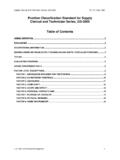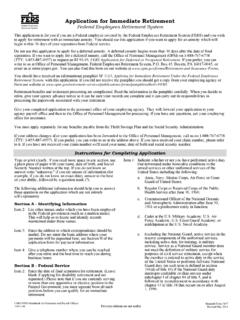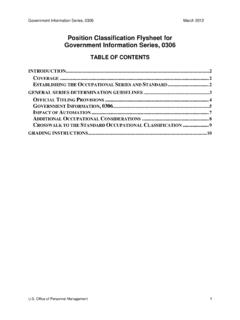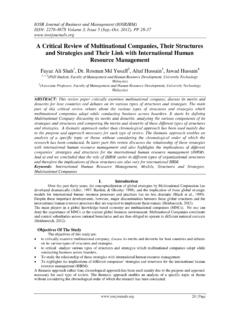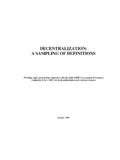Transcription of Administrative Analysis Grade Evaluation Guide
1 Administrative Analysis Grade Evaluation Guide TS-98 August 1990. Administrative Analysis Grade Evaluation Guide TABLE OF CONTENTS. 2. EXCLUSIONS .. 2. BACKGROUND 3. HOW TO USE THIS 3. Grade CONVERSION TABLE .. 4. FACTOR LEVEL RELATIONSHIPS .. 5. FACTOR LEVEL 5. FACTOR 1, KNOWLEDGE REQUIRED BY THE 5. FACTOR 2, SUPERVISORY 9. FACTOR 3, GUIDELINES .. 11. FACTOR 4, 12. FACTOR 5, SCOPE AND 16. FACTOR 6, PERSONAL CONTACTS AND. FACTOR 7, PURPOSE OF CONTACTS .. 20. FACTOR 8, PHYSICAL 21. FACTOR 9, WORK ENVIRONMENT .. 21.
2 Office of Personnel Management 1. Administrative Analysis Grade Evaluation Guide TS-98 August 1990. COVERAGE. This Guide provides Grade level criteria for nonsupervisory staff Administrative analytical, planning, and evaluative work, at Grade GS-09 and above. Work covered by the Guide is Administrative in nature and does not require specialized subject matter knowledge and skills. While such work does not require specialized educational preparation, it does require a high degree of qualitative and/or quantitative analytical skills, the ability to research problems and issues, written and oral communication skills, and the application of mature judgment in problem solving.
3 EXCLUSIONS. 1. Full performance level (nontrainee) positions below Grade GS-09 involved in the performance of one- Grade interval technician or assistant work in a support capacity. Such positions should be graded using standards and guides for clerical, assistant, and technician work. 2. Position which consists solely of duties and responsibilities related to the line management or delivery of agency programs. Such work typically requires specialized subject matter knowledge and skills and should be graded through reference to the appropriate subject matter standard.
4 3. Positions for which specialized technical skills or educational qualifications are of paramount importance to satisfactory performance of the work ( , education of the type usually gained through completion of specified academic course-work or extensive experience in an occupation). Such positions should be evaluated through reference to an appropriate subject matter standard. 4. Professional and scientific positions primarily concerned with the Analysis of public policy issues and their impact on social, economic, scientific, legal, diplomatic, environmental, and other issues of national and international significance.
5 Such positions are evaluated by the Policy Analysis Grade - Evaluation Guide . 5. Positions involving financial or other specialized Administrative duties and responsibilities which are more thoroughly covered by criteria in specific occupational standards ( , the Financial Management Series, GS-0505; series covered in the Job Family Position Classification Standard for Professional and Administrative Work in the Accounting and Budget Group, GS-0500). Such positions should be evaluated through reference to the appropriate subject matter standard.
6 Office of Personnel Management 2. Administrative Analysis Grade Evaluation Guide TS-98 August 1990. BACKGROUND INFORMATION. This Guide is designed specifically to evaluate staff analytical, planning, and evaluative work concerned with the Administrative and operational aspects of agency programs and management. Although line work is excluded from coverage, the Guide may also be used for evaluating staff analytical duties of positions primarily engaged in line management or program administration. Typical positions covered by this Guide require knowledge of: (1) the overall mission, functions, and organization of the agency or component; (2) the principles, functions, and processes of management and the organization of work; (3) agency program operations, processes, goals, and objectives; and (4) evaluative, planning, and analytical processes and techniques (quantitative and qualitative).
7 Knowledge is applied in a staff advisory capacity to line management in support of: planning, development, and execution of agency programs; the Administrative management of agencies and their component organizations; or the performance of related functions requiring comparable knowledge and skills. The Guide is intended primarily for use in evaluating two- Grade interval positions in the General Administrative , Clerical, and Office Services Group, GS-0300. Since this is a functional Guide , it may also be used as an additional source of classification guidance for two Grade -interval Administrative work in other occupational groups not covered by published Grade level criteria, and where the positions involved require knowledge and skill in the application of analytical and evaluative concepts, methods, and techniques comparable to those described in this Guide .
8 HOW TO USE THIS Guide . Positions should be evaluated on a factor-by-factor basis using the (FES) factor level descriptions contained in this Guide . Total points for all factors are converted to Grade level using the table below. The basic instructions and concepts contained in the Instructions for the Factor Evaluation System (May 1977) should be applied in the Evaluation of positions. The Guide contains work illustrations designed to assist users in selecting the proper levels for Factors 1, 4, and 5. The illustrations provide an expanded frame of reference for identifying the concepts of these factor levels.
9 Users should not rely solely on the illustrations in evaluating positions, since they reflect a rather narrow range of actual work examples for positions covered by this Guide . Instead, users should attempt to match the intent of the various factor levels, and within the illustrations, find concepts and examples which are comparable to those of the position being evaluated. The Guide does not provide criteria for trainee or developmental work below Grade GS-09. Agencies may establish positions at these levels as needed for entry and development using the (FES) primary standard for factor levels falling below those described in the Guide , related classification standards, and sound classification and position management practices.
10 Office of Personnel Management 3. Administrative Analysis Grade Evaluation Guide TS-98 August 1990. The series of a position classified in whole or in part by this Guide is determined by the assigned duties and responsibilities and the qualifications required for the work. Official position titles are established by published classification standards for the series or by the general instructions for titling in the Introduction to the Position Classification Standards. Grade CONVERSION TABLE. Total points on all Evaluation factors are converted to GS Grade as follows: GS Grade Point Range 9 1855-2100.




